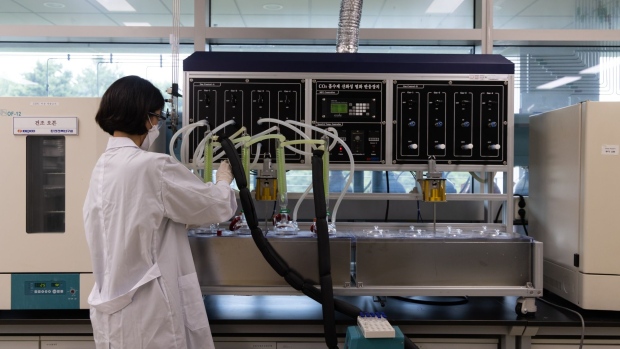Jul 8, 2021
Inside the Lab Striving to Make Korea’s Worst Polluter Net-Zero
, Bloomberg News

(Bloomberg) -- In a sprawling, leafy campus in the heart of South Korea, about 500 engineers are tackling the challenge of making the nation carbon neutral by mid-century.
These experts aren’t working for a university or a nonprofit. They belong to Korea Electric Power Corp., the state-owned utility that’s South Korea’s worst polluter and has been a frequent target of criticism from environmentalists and investors like BlackRock Inc.
As nations including South Korea set more aggressive targets to reduce greenhouse gas emissions and curb reliance on fossil fuels, major emitters such as global utilities are coming under increased pressure. A peek inside Kepco’s massive research complex gives some insight into how those power generators are responding.
“The importance of developing renewable energy has been growing within Kepco, indicating that the government’s energy policy is going through a major shift,” said Kim Dohyung, a principal researcher at the Kepco Research Institute. When Kim joined the company 17 years ago, there was one small team dedicated to renewables, and now work on the field is the backbone of the entire institution, he said.
One of the key projects at the institute in Daejeon, a city surrounded by mountains and national parks, is focused on the removal of sulfur hexafluoride, the most potent of the greenhouse gases. SF6, which accumulates in the atmosphere and doesn’t degrade for centuries, has a significant role for utilities, acting as an insulator for power equipment.
Kepco’s new technology to remove the gas will see the company install decomposition facilities at its power stations beginning in 2024. The company expects to cut 66 tons of SF6 gas per year, equivalent to about 1.5 million tons of carbon dioxide.
Carbon capture, a technology being pursued across multiple industries, is another major focus, particularly emissions from coal plants. Since 2013, Kepco has been operating the nation’s biggest amine-based facility that captures 200 tons of CO₂ per day from its Boryeong coal station. Amine solvent is used to bind with CO₂ from an exhaust stack.
The Daejeon research facility has its own CO₂ capturing plant, housed in a sweltering hot building, while at the other end of the vast campus -- a car or bicycle ride is needed to get around -- staff in a chemistry lab work on improving the amine-based liquid absorbent that’s used in the process.
“Our goal is to reduce the cost of capturing CO₂ to below $30 a ton,” said Lee Junghyun, a senior researcher at the center’s climate change technology group. High concentration capture from coal currently can cost as much as $46 a ton, BloombergNEF said in a report last year.
Read more: Solar Is Dirt-Cheap and About to Get Even More Powerful
Elsewhere in the complex, senior researcher Kim is at a glass booth with attached gloves and vacuum pump to prevent contamination. The center’s work on perovskite solar cells, which use a thinner and more transparent material than traditional polysilicon, could boost efficiency, or enable regular glass windows to generate power.
Innovations in renewable energy have also seen the firm launch a 1,500-ton offshore wind installation vessel that the company says can use improved methods to cut the time and cost of fixing giant turbines to the sea floor.
Other Kepco research efforts at the institute are focused on digitalizing power stations, increasing grid capacity and EV charging.
Researchers have helped Kepco cut its total emissions -- including from power-generating subsidiaries -- to 202.2 million tons in 2019, the lowest since 2015, according to Bloomberg data. Even so, the company faces a difficult task to meet a corporate target of net zero emissions by 2040, a decade ahead of the government’s goal, according to BloombergNEF analyst David Kang.
“While research on emerging technologies could be helpful, Kepco’s decarbonization strategy should be focused on retiring its fossil fuel assets and strengthening the grid network to better support the rising penetration of renewable energy,” Kang said.
©2021 Bloomberg L.P.


